I needed a “fun” food project this week, so I decided to make some homemade pork gyoza, which is kind of an updated version of a recipe I made almost six years ago (whoa!), Pork & Ginger Pot Stickers. I tweaked the filling a bit and decided to try the more traditional (and more difficult) pleated folding style. These tasty little dumplings are great to keep in your freezer so you can cook a few at a time to add to add to your meal.
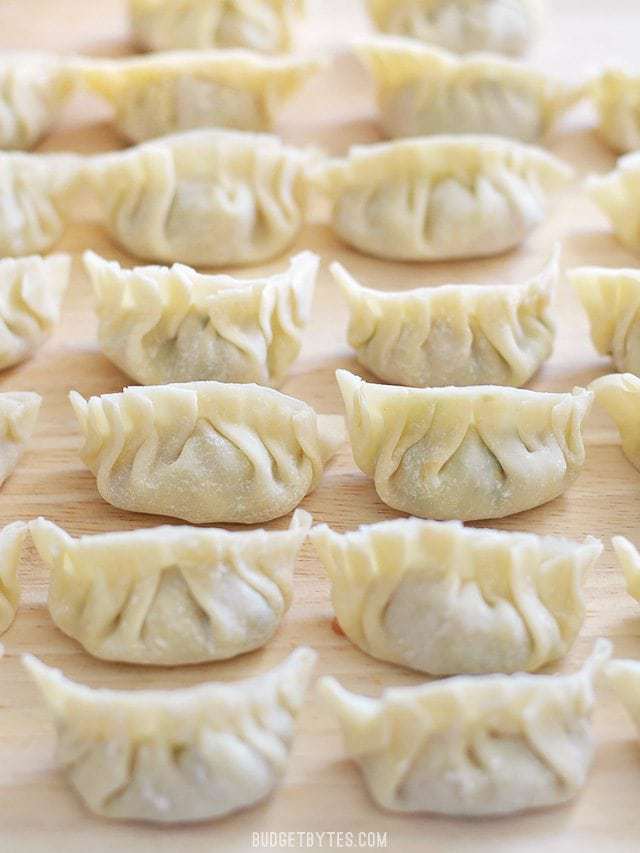
This post contains some affiliate links, which means that we make a small commission off items you purchase at no additional cost to you.
What Are Gyoza?
Gyoza are a Japanese pan-fried dumpling made with a delicate wrapper and filled with seasoned vegetables and meat (or just vegetable) filling. The gyoza are pan-fried to create a deliciously crispy bottom, then briefly steamed to give them a delicate finish. The recipe below is just my interpretation of this traditional Japanese food, so if you’d like to try an authentic recipe, see a video of them being made, and learn more about these tasty little dumplings, check out this recipe for Gyoza from Just One Cookbook.
Can I Use a Different Meat?
Yes, if you prefer to avoid pork, you can swap in ground turkey or chicken. OR, you can mince some fresh shrimp and use that. Just make sure that whatever you’re using it is chopped or ground into a super fine texture so that it cooks quickly in the gyoza.
Freeze Your Pork Gyoza
Once you finish filling and folding your pork gyoza, you can freeze them, which means you can keep them on hand and pop a handful in a skillet any time you get the craving. So go ahead, make a big batch, and reap the benefits later! To freeze the gyoza, lay them on a parchment-lined baking sheet so they’re not touching, freeze until solid, then transfer to a heavy-duty freezer bag for longer storage.
Frozen gyoza can be dropped straight from the freezer into a pot of boiling water to cook. Let them boil for 3-5 minutes, or until they begin to float, then fry as directed below.
Pennies on the Dollar!
And let’s not forget the cost… Even though I used expensive ground pork, these little guys turned out to be only about $0.18 each. An appetizer order of Pork Gyoza at a restaurant will easily run you $6-$8, and you get how many? Maybe six? So yeah, about $1 each at a restaurant.
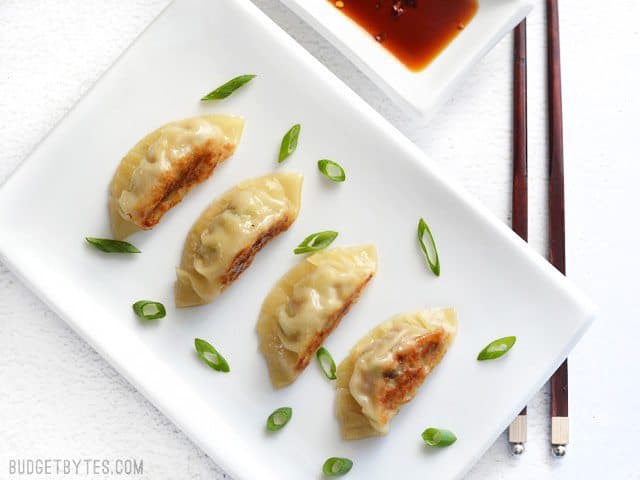
So, want to see how it’s done?
Pork Gyoza
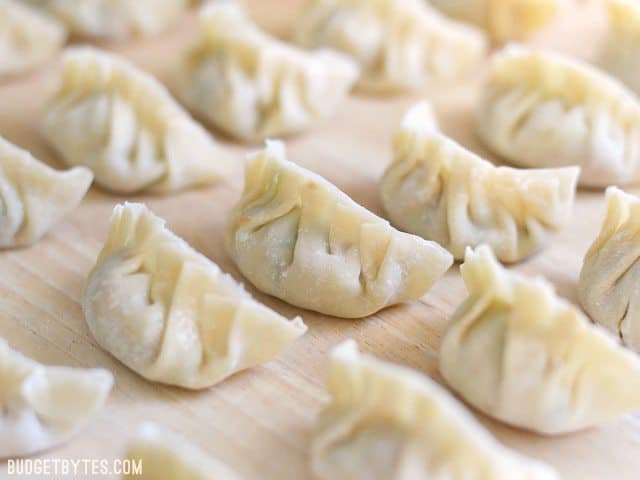
Ingredients
- 4 cups finely shredded or chopped cabbage ($1.42)
- 2 Tbsp canola or vegetable oil, divided ($0.04)
- 3 green onions ($0.44)
- 2 cloves garlic ($0.16)
- 1 Tbsp grated ginger ($0.10)
- 1/2 Tbsp soy sauce ($0.05)
- 1 tsp sesame oil ($0.11)
- 1/2 lb. ground pork ($3.00)
- 50 gyoza or wonton wrappers ($3.69)
Instructions
- Sauté the cabbage with 1 Tbsp canola or vegetable oil in a large skillet over medium heat until wilted to half its volume. Transfer the cabbage to a large bowl.
- Slice the green onions, mince the garlic, and grate or chop the ginger. Add the onions, garlic, ginger, soy sauce, sesame oil, and ground pork to the bowl with the sautéed cabbage. Massage the mixture with your hands until it is evenly mixed and slightly sticky or tacky in texture.
- Spoon about one teaspoon of the pork mixture into the center of a wrapper. Dip a finger in water and wet the outer rim of the wrapper. Fold the wrapper over the filling and pinch the edges to close (here is a video demonstrating different folding styles).
- When ready to cook the gyoza, heat 1 Tbsp canola or vegetable oil in a non-stick skillet over medium heat. Working in batches, add the gyoza with the seam side up, and fry until the bottom is golden brown and crispy. Using the lid as a shield, pour about 1/4 to 1/3 cup water into the skillet and quickly place the lid on top to contain the steam and splatter. Let the gyoza steam in the skillet for 1-2 minutes, or until most of the liquid has boiled away. Remove the lid and let the gyoza cook for a minute more, or until the bottom is crispy again. Serve hot.
See how we calculate recipe costs here.
Notes
Nutrition
While you’re at it, make a batch of Simple Sweet and Sour Sauce to dip your gyoza!
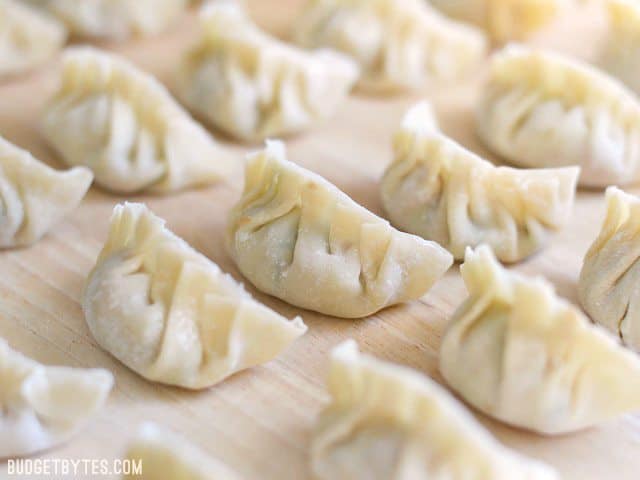
How to Make Homemade Gyoza – Step by Step Photos
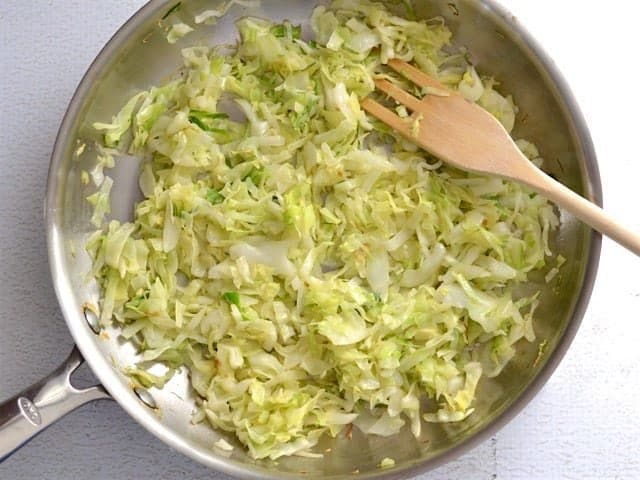
Begin the gyoza by sautéing the cabbage for the filling. I used 1/2 of a small head of cabbage, or about 4 cups once finely shredded. Chop or shred the cabbage as finely as possible to make it easier to mix with the pork and fill the tiny gyoza. Nappa cabbage is best, but if you can’t get it (my store was out of Nappa), regular green cabbage will also work. Sauté the cabbage with about 1 Tbsp oil in a large skillet over medium heat until it has wilted to about half of its original volume (5-8 minutes). Transfer the sautéed cabbage to a large bowl.
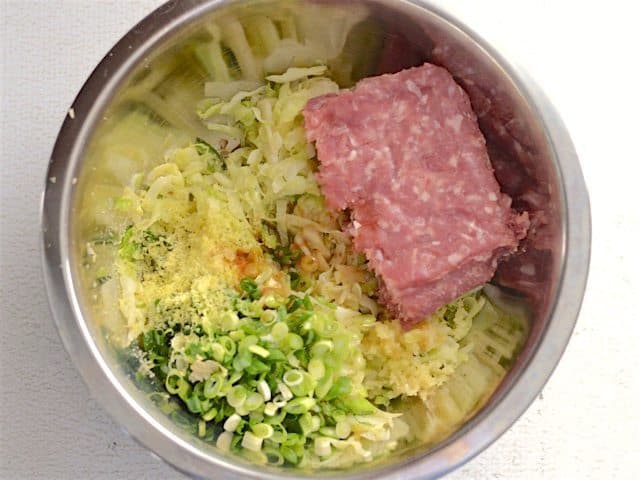
Thinly slice three green onions, mince two cloves of garlic, and grate about 1 inch of fresh ginger (about 1 Tbsp). Add the onions, garlic, and ginger to the bowl, along with 1/2 Tbsp soy sauce, 1 tsp sesame oil, and 1/2 lb. ground pork.
Mix the ingredients with your hands until everything is evenly combined and the mixture is slightly sticky or tacky.
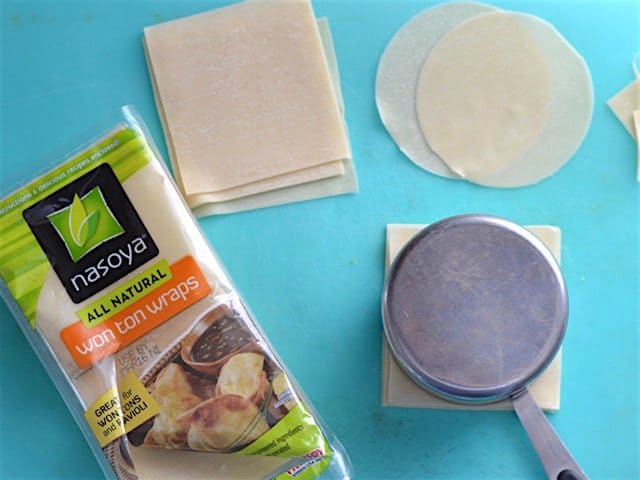
If you want to do the fancy pleated folds, you’ll need round wrappers, but you can do the easy folding style with square wrappers. If you can only find square wrappers, you can use a cookie cutter or any other sharp round object (like my metal measuring cups!) to cut them into circles. Make sure to not let the wrappers sit out uncovered for very long, though, because they’ll start to dry out and become brittle. You can either keep them in the package or cover them with a slightly damp paper towel.
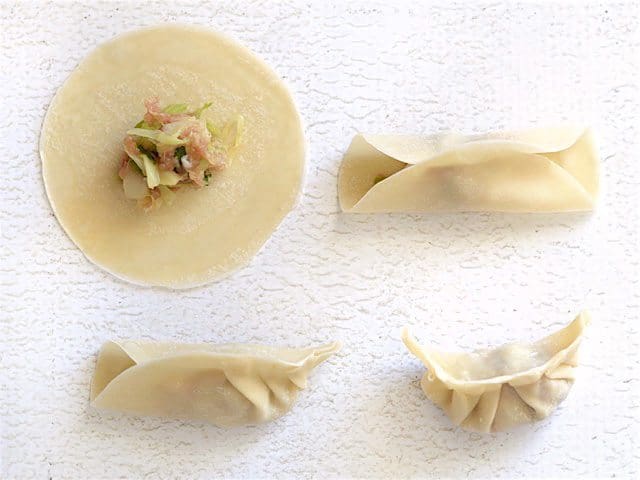
It takes far less filling to fill each of the wrappers than you’d imagine. Over filling makes them extremely difficult to fold. I used about one teaspoon in each wrapper. Dip your finger in water and wet the outer edges of the wrapper to help them stick or glue together. It’s best to see how to fold these little suckers in action, so here is a link to a video that demonstrates three folding styles, including the easiest way and this more intricate pleated fold. However you choose to fold, make sure to pinch the edges tight to keep them from opening.
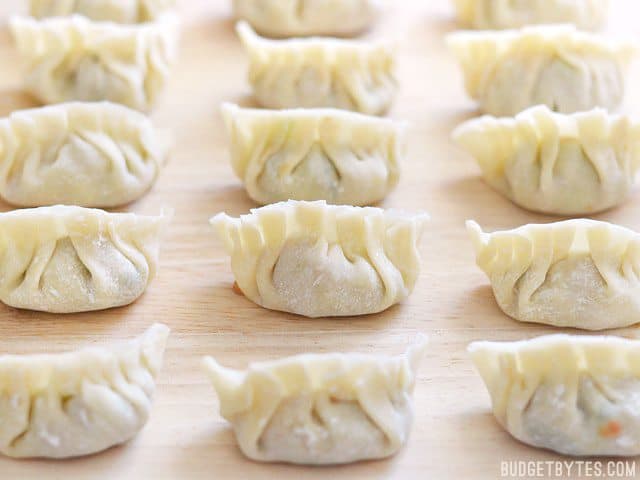
As you fill and fold the gyoza, line them up on a baking sheet or cutting board, with the seam side up. You can freeze them at this point, or cook them.
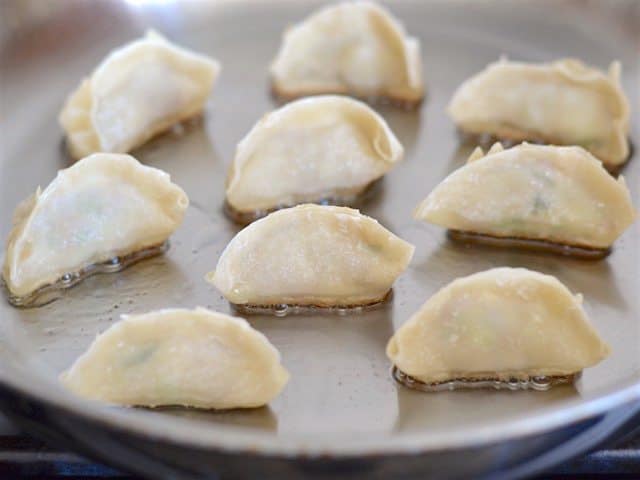
To cook the Pork Gyoza, heat 1 Tbsp canola or vegetable oil in a large non-stick skillet over medium heat. Add the gyoza, seam side up, and fry until they are brown and crispy on the bottom. (P.S. I took these photos in a stainless steel skillet, but switched to a non-stick for the next batch. They don’t call these suckers “pot stickers” for nothing. Non-stick will make this process a LOT easier.)
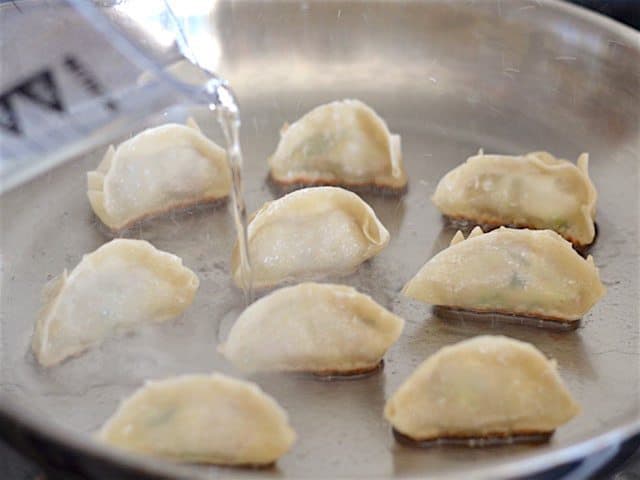
Use the lid of the skillet as a shield and carefully pour about 1/4 to 1/3 cup water into the skillet. Place the lid on top as quickly as possible to contain the splatter and steam.

Let the gyoza steam in the skillet for 1-2 minutes, or until most of the water has evaporated and the wrappers look slightly translucent (the water should be rapidly simmering). Remove the lid to let the last bit of water evaporate and the bottoms of the gyoza crisp up again. Once crispy, remove to a plate and cook a second batch if desired.
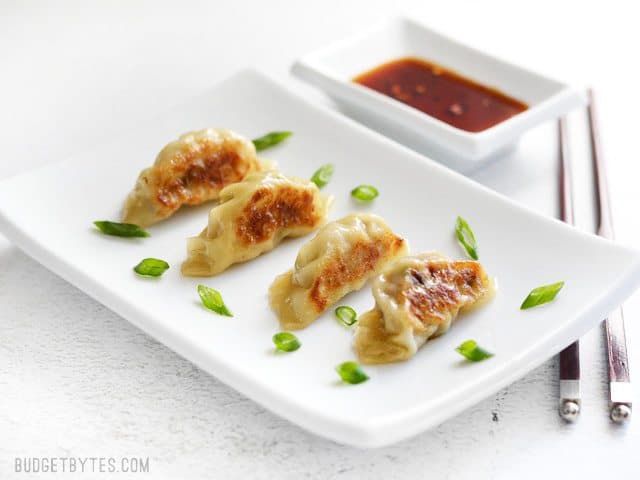
And that’s it! Just a few minutes in the skillet and they’re done. Gyoza are often served with a mix of soy sauce and rice vinegar (2:1 ratio), to which you can add a little red chile paste for more flavor. Or just pop ’em in your mouth as is. :)
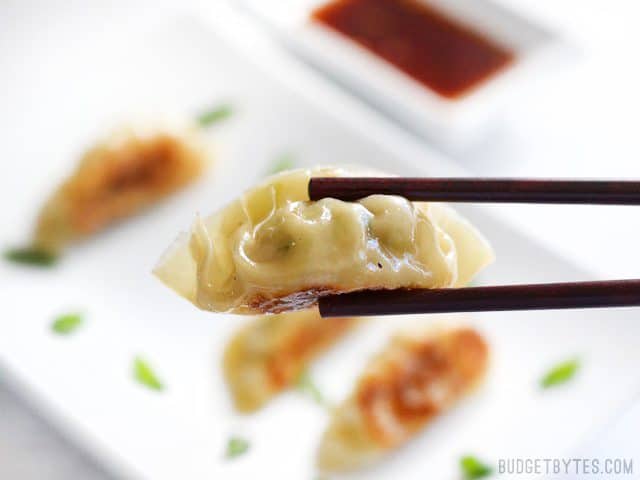
Mmmmm Pork Gyoza!
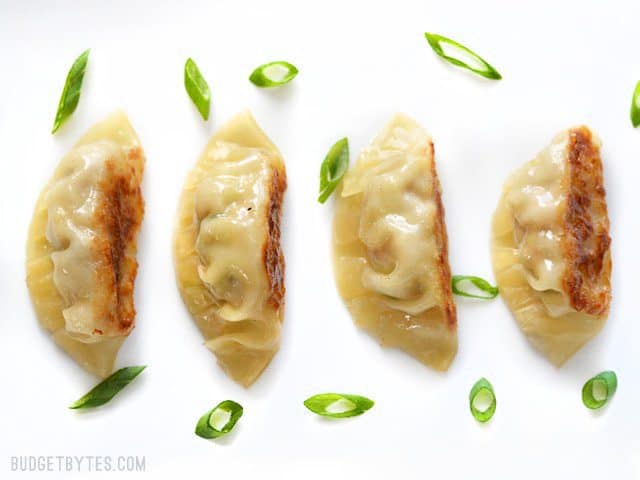


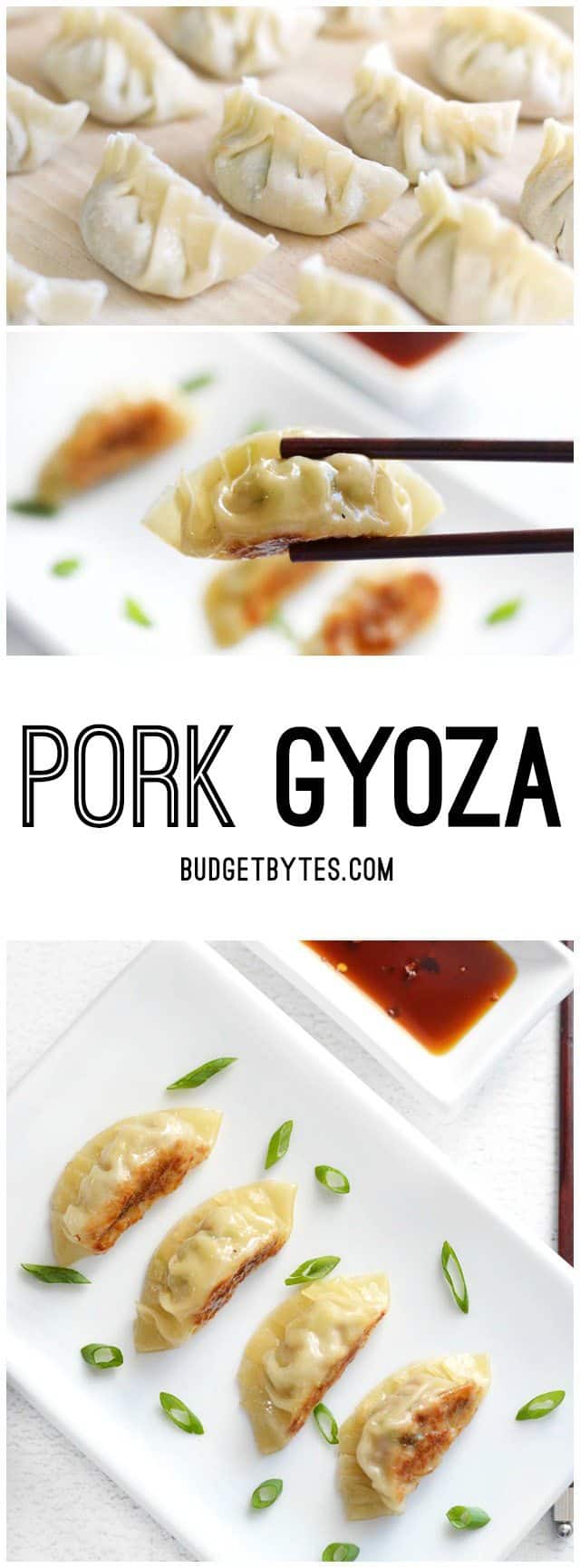
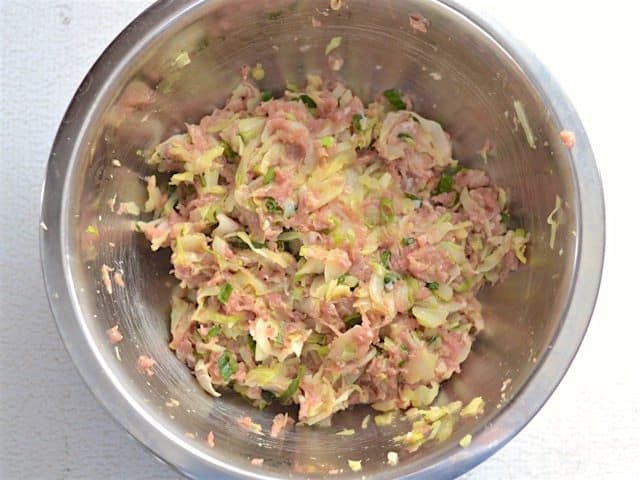
Nice, that’s a pretty authentic recipe too! Instead of chili flakes in the sauce, a more authentic version would be to use chili oil, often called ‘La-yu’. It’s what they use in Japan.
Awesome recipe! The wrappers are pretty easy to make if you are feeling a tad more ambitious (and are only flour , water and salt).
Hi Beth, I’ve been reading your blog for YEARS and this is the first time I’ve commented. I hope this doesn’t come across as creepy when I say that I’m sorry for the recent shitty turn of events and am giving you a big hug. You are amazing and your blog has helped so many people (like me!). I say go on wit’ yo bad self and eat all the nachos+cheese and gyozas that you want, and thanks for sharing these recipes – we all have times when these recipes are like a lifeline to sanity. I heart your work very much and am grateful for all that you share! (PS: Your cookbook is amazing – I bought extra copies for some of my family members who could use the financial cooking advice!)
Thank you!! It’s very much appreciated and not at all creepy. :) Those nachos took me from “Ugh!” to “You know, the clasp on both the purse and wallet were broken anyway… ;) “
Beth, just wanted to say I’m sorry to hear about what happened to you this week. I hope you don’t lose your faith in humanity! :-) Thank you for all of these wonderful recipes that have given me confidence that I can do it! Believe me I’ve been a hopeless cook most of my life, but I’m turning that around thanks to you!
Cheers!!
Thank you! I haven’t lost my faith in humanity. :) In fact, I only felt a bit sympathetic towards the person.
Just wanted to say I love your blog and sorry for your bad week. Mine has been terrible too. Moving out of an apt with roommates after 3 years and in with my boyfriend. Turns out one of them and his boyfriend have stolen my phone charger and two checks from my check book! I can’t prove it, but they didn’t run away from home and they are gone. My bank has already frozen and is changing my account, but very upsetting. I might need to make some nacho cheese dip and gyoza this week!
Do it! The nacho cheese helps. ;)
We always dipped our gyoza in Ponzu sauce while in Japan. They also had fresh gyoza in the deli section. What a treat that was. I’ll have to try this for sure. Hope your week goes better.
Yaay for potstickers! We make them a few times a year at my house. This last time I chopped the veggies in the food processor, then added the meat and let it mix on a slower setting until it made a paste. We boiled some up for thr Lunar New Year last weekend, and froze the rest. If you don’t have enough wrappers, the filling freezes decently in a zioloc bag.
You’re so great for turning such a negative into a positive! You’re totally committed to your audience and for that, we are grateful. You should have whatever you want for the next month! :)
I’m sorry to hear of your awful week! Hoping things will get better for you.
Thank you for this wonderful recipe. I can’t wait to try this
Mmmm! I have a bag of these in my freezer from last weekend. I blend all the veg up and skip the sauté though. I also opted for a full-on fry since it was the weekend. Love your site & recipes. Great ideas and inspiration!
Sorry about your terrible week! That sounds awful! I usually buy premade frozen ones, but this looks like a fun (and less expensive). I’ve probably said it before, but thank you for all that you do. This is where I look for recipes I actually want to make.
Sorry for your tough week. We really do appreciate all you take time to cook and write up each week in your recap. If anyone deserves a “fun food” break it’s you! Thanks for all you do Beth
I was already planning to make shrimp potstickers this week. Maybe I could do half and half.
Cutting them into round shapes is genius!!! I’ll try your recipe soon. I usually use the Chinese chives with pork. They taste good too! But cabbage IS cheaper, great idea. How would I freeze these though? Cook first or raw? Thanks!
Bummer about your car and purse but something good came of it all – POTSTICKERS. I love potstickers which I always buy pre-made but have wanted to learn how to make and this was a great tutorial! You have inspired me. I so look forward to your posts and recipes. I have tried many of your recipes and look forward to trying many more. Thank you Beth. ;-}